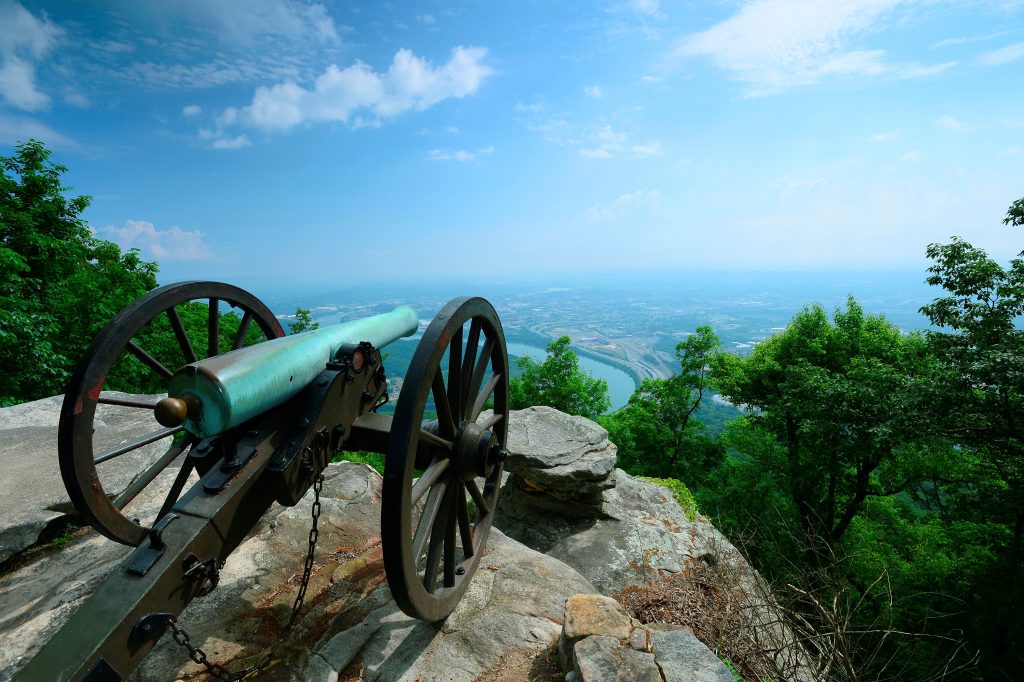A Thousand Words a Battle: Chattanooga
Battle of Lookout Mountain, Chattanooga
Sept. 18-20, 1863

The Battle of Lookout Mountain is vested in romance and poetry but proved to be one of the most iconic moments of the American Civil War. General Joseph Hooker, commanding an amalgamated force of men from all three of the war’s principal Union armies, led a diversionary attack against the mountain on the morning of November 24 in what became known as the “Battle Above the Clouds,” which turned into a victory none but Hooker seemed to have expected.
One young soldier, Sgt. Ambrose Henry Hayward of the 28th Pennsylvania Infantry of the XII Corps, took pen to paper a few weeks later to recall the battle:
“We moved forward in light marching order across Lookout Creek forming in line of Battle on the opposite side. Skirmishers were ordered to the front when we advanced with no more doubts as to the task we had before us. We moved without much opposition for nearly a mile at the base of the mountain driving in the Rebel pickets and opening communications with the center of the storming party who soon crossed the Creek. All being ready, we began to Climb.
The 3rd Brigade who were on the extreme right soon became engaged with the enemy, but their well known Valor was too much for the Rebels to stand and they drive them from their breastworks before we had to get up. We were often encouraged by the appearance of squads of Prisoners and were fully Convinced of the surprise when we reached their camp and found knapsacks, Uniforms, &c., guns, and their mush, left to cook itself upon the fires.
We were yet but half way up, but Geary ordered us to halt to let (as we supposed) the left wing have time to get up. While we were thus resting, the Rebels opened upon us. . . . [W]e took shelter behind rocks, the missiles flying harmlessly over our heads. We soon heard the well known Cheer which follows the Charge, and in a few moments the Rebel guns were silent. We had been purposefully shown to attract their attention, and, before they were aware of it, the 3d Brigade were upon them. This was a grand affair and gave us high hopes that our great attempt would yet prove a great success.
We moved on passing the Captured Guns and a large squad of Prisoners. . . . We made slow progress . . . finding that it grew steeper and more impassable, we soon learned the Rebels had made another stand. They had found their last ditch and were now defending behind Natural breastworks of rocks their only road by which they could withdraw their Artillery. Here they made a stubborn resistance. Their artillery was of no use to them for they could not depress them low enough to get range upon us as we were nearly under the bluff where their Guns were in position. We lay down flat upon the ground under fire of their Musketry, there being no chance for a third of the troops to fight.
Thus we passed 2 hours listening to the different tones of the Rebel bullets. A few had been wounded. I saw one man in Co. F hit in the breast. Our Brigade was soon ordered to the rear and then to the right as a support to the 3d Brigade which had done most of the fighting during the day. We gladly welcomed the night which was fast coming on, if with it, it would put an end to that heart sickening sensation which Whistling bullets produce. . . .”
Hayward also noted, “Come and see Lookout Mt. or you will never know what wonderful deed the American Soldiers have done.”[1]
— William Lee White
[1] Ambrose Henry Hayward, Last To Leave the Field: The Life and Letters of First Sergeant Ambrose Henry Hayward, 28th Pennsylvania Volunteer Infantry (Knoxville, TN: University of Tennessee Press, 2010), 195-198.
A great account. Thanks!
I enjoy this format, with primary use of eyewitness reports.